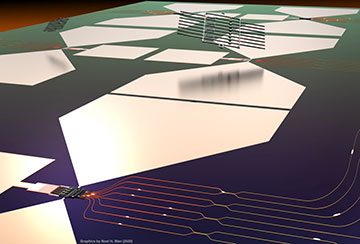
Arrays of spin qubits known as quantum microchiplets, shown in the top half of this artist’s impression, are combined in an integrated photonic circuit (bottom). [Credit: Noel H. Wan]
Scientists in the U.S. have shown how to assemble large numbers of solid-state qubits by combining them in a photonic integrated circuit. Their hybrid technique involves selecting arrays of “artificial atoms” made from tiny defects in a very thin slice of diamond crystal, and then mounting these arrays on a suitable substrate (Nature, doi: 10.1038/s41586-020-2441-3).
The researchers say that the new scheme could in future allow quantum information technologies to be scaled up in a way similar to state-of-the-art classical integrated circuitry.
Just keep spinning
So-called spin qubits are encoded in the spins of electrons or nuclei that are trapped within atomic-scale crystal defects. Within diamond, for example, suitable defects can be created when two carbon atoms from the crystal lattice are replaced by a gap and an atom of a different element. The qubits are placed into a superposition using microwaves and then read out via laser pulses at a specific visible wavelength.
Such spins have comparatively long coherence times—up to several minutes— and couple efficiently to photons. But noise and variation within a crystal's structure have limited the number of qubits that can be operated together, creating a hurdle that must be overcome if practical applications are to be developed. For example, the memory inside quantum repeaters that would distribute entanglement across a future quantum internet requires at least several hundred qubits, while a large-scale quantum computer, complete with error correction, is likely to need millions.
Some groups are already taking their lead from advanced microelectronics, and combining sub-components fabricated separately onto a single substrate. This has, for example, seen photonic integrated circuits melded with both sources and detectors of single photons—quantum dots and superconducting nanowires, respectively. However, these components are assembled one at a time, making it hard to scale up to very large devices.
Creating vacancies
The latest work, carried out by Dirk Englund, Noel H. Wan, Tsung-Ju Lu and colleagues at the Massachusetts Institute of Technology, USA, instead involves fabricating many arrays of qubit-containing waveguides and then selecting those with the fewest imperfections for assembly on a separate substrate.
Englund and co-workers start off by implanting germanium and silicon ions into a thin sheet of diamond to create tiny defects known as vacancy centers. They then combine multiple such centers into what they call quantum microchiplets—arrays of waveguides that they etch into the diamond using electron-beam lithography. The final step involves placing these chiplets into sockets within a thin layer of aluminium nitride grown on sapphire. Unlike silicon, both diamond and aluminium nitride are transparent at the optical wavelengths needed to excite and read out from the vacancy centers.
The researchers found that they could make chiplets containing up to 64 waveguides. However, larger chiplets tend to have more imperfections. So they settled on using 8-channel chiplets, and were able to successfully transfer 16 such arrays to the integrated circuit. The result was a 128-channel “photonically integrated quantum emitter chip.”
According to Englund and colleagues, this is the largest such chip made by any group to date. Wan says that each channel contains more than 1 qubit so that “technically there are more than 128” qubits. But he explains that they used the term “channel” because they have not yet carried out experiments showing that the qubits “can be entangled in a large lattice or used simultaneously.”
Toward quantum repeaters and processors
The researchers nevertheless showed that the qubits are stable and long-lived, and also that they can tune them so that pairs of qubits absorb and then emit light at almost exactly the same frequency. They claim that this ability to combine large numbers of nearly indistinguishable and tunable artificial atoms “marks a key step towards multiplexed quantum repeaters and general-purpose quantum processors.”
Wan points out that they still have to develop large-scale control techniques to entangle the qubits, as would be needed in an actual quantum processor. As such, their scheme is not yet comparable to rival technologies. Researchers at Google, for example, last year reported using 53 superconducting qubits to carry out a specific algorithm far faster than would be possible on a classical supercomputer.
The researchers say it will be important to try and automate the manufacturing process as well as incorporate other photonic and electronic components into the circuits, such as modulators and single-photon detectors. But they add that their scheme has the advantage of being compatible with other types of spin qubit, such as different defects in diamond, defects in other semiconductor crystals, quantum dots, or rare-earth ions in crystals.
